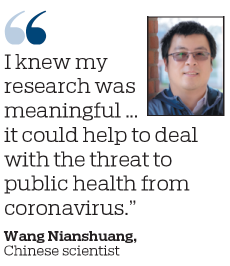Scientist's key help with vaccine
Research that journals rejected ended up helping to solve coronavirus puzzle
When Wang Nianshuang first found a way to stabilize the shape-shifting spike protein of a coronavirus in 2016 the then postdoctoral researcher and his collaborators had a hard time finding a journal willing to publish the results.
"The paper was rejected by five top scientific journals, and when it was finally published, one year had already passed," Wang, 34, told China Daily recently from his home in New Haven, Connecticut.
However, that rejected research became a key component in engineering effective COVID-19 vaccines produced by the US biotech firm Moderna and the US pharmaceuticals company Pfizer and its German development partner BioNTech. The technology is also being used by Johnson& Johnson, Novavax, Cure-Vac and Translare Bio.
"Nianshuang has made an incredible impact on the race to develop COVID-19 vaccines, and his groundbreaking research will help to save many lives," said Jason McLellan, a molecular biologist at the University of Texas at Austin, who supervised Wang's research from 2014 until this August, when Wang joined Regeneron Pharmaceuticals as a scientist.
"I knew my research was meaningful in the sense that it could help to deal with the threat to public health from coronavirus, but never in my wildest dream could I imagine it would be on such a large scale," Wang said. "I'm still a little dazed from all of this."
Growing up as a farmer's son in a rural part of Shandong province, Wang found he might have some "special talent" in biology.
After finishing undergraduate studies at Ocean University of China in Qingdao majoring in biology, Wang was admitted to the PhD program at Tsinghua University in Beijing in 2009 on recommendation without exams because of his academic prowess.
When the second pathogenic coronavirus MERS-CoV (Middle East respiratory syndrome coronavirus) emerged in 2012, Wang and his adviser, Wang Xinquan, associate dean at the School of Life Sciences at Tsinghua, became interested in the coronavirus.
"Coronavirus seemed to pop up every 10 years, first with the appearance of SARS (severe acute respiratory syndrome) in 2003," Wang said. "I felt then that coronavirus would become a serious threat to global public health one day, and such research would have very practical application."
In 40 days Wang determined that the structure of the MERSCoV S protein was bound to receptor DPP4, illustrating how a virus uses the key to open the lock on human cells.
Promising antibodies
Later, collaborating with another Tsinghua professor, Zhang Linqi, and his laboratory, Wang and his colleagues identified two promising human neutralizing monoclonal antibodies-the first two in the world-capable of blocking MERS infection. They had hoped to develop an effective MERS treatment from that.
In 2014, wanting to continue coronavirus research, Wang joined McLellan's laboratory as a postdoctoral researcher first at Dartmouth College in Hanover, New Hampshire, and later at the University of Texas at Austin, following McLellan.
At that time, McLellan's laboratory was working with Barney Graham, deputy director at the National Institutes of Health Vaccine Research Center, to develop vaccines targeting emerging coronaviruses, including SARS and MERS viruses. To achieve that, first they had to find a way to stabilize the virus' shape-shifting spike protein.
McLellan gave the task to his only postdoctoral researcher in his laboratory at the time, and it took Wang about two years to complete.
"Sometimes I'd get very discouraged when nothing was achieved after a month or weeks of efforts," Wang said. "However, the belief in the importance of this research kept me going."
McLellan said: "Nianshuang is a tremendous scientist who works incredibly hard in the laboratory. There was a lot of trial and error, but Nianshuang never gave up."
It was not until Wang turned to another coronavirus, HKU1, in collaboration with Graham's laboratory, that things started to improve. The HKU1 spike is a relatively more stable protein. The high-resolution cryo-EM structure of the HKU1 spike was soon determined in Andrew Ward's laboratory at the Scripps Research Institute in San Diego, which provided an ideal template for Wang to generate his designs.
Wang further experimented with more than 100 different mutations and finally identified two genetic mutations capable of stabilizing the spikes.
"The technical aspect is complicated," Wang said. "To illustrate it simply, I used mutation design, as if inserting a steel structure to fix the protein in its active state, so that it won't change its shape."
It was a year before the research manuscript was published in 2017.
"At that time, MERS had virtually disappeared, and the journal editors and reviewers didn't think the related research could be significant, short of an immediate practical application," Wang said.
That experience discouraged Wang for a while. However, the research was evaluated, confirmed and implemented by other laboratories, and papers were published. "In the end, we got good recognition in this small circle of coronavirus research," he said.
When the COVID-19 outbreak arrived, McLellan and his team immediately realized that they were well prepared and should react as soon as possible.
"Once the spike sequence was made available by Chinese researchers on Jan 10, we had the SARS-CoV-2 stabilized spike variant designed within minutes," McLellan said.
"Nianshuang then worked relentlessly for 10 days to clone the stabilized spike gene so that we could produce the protein in our lab for structural studies."
The research paper describing the first structure of the SARS-CoV-2 spike was submitted to the magazine Science, which expedited its peer review process and published the paper in nine days.
mayzhou@chinadailyusa.com














